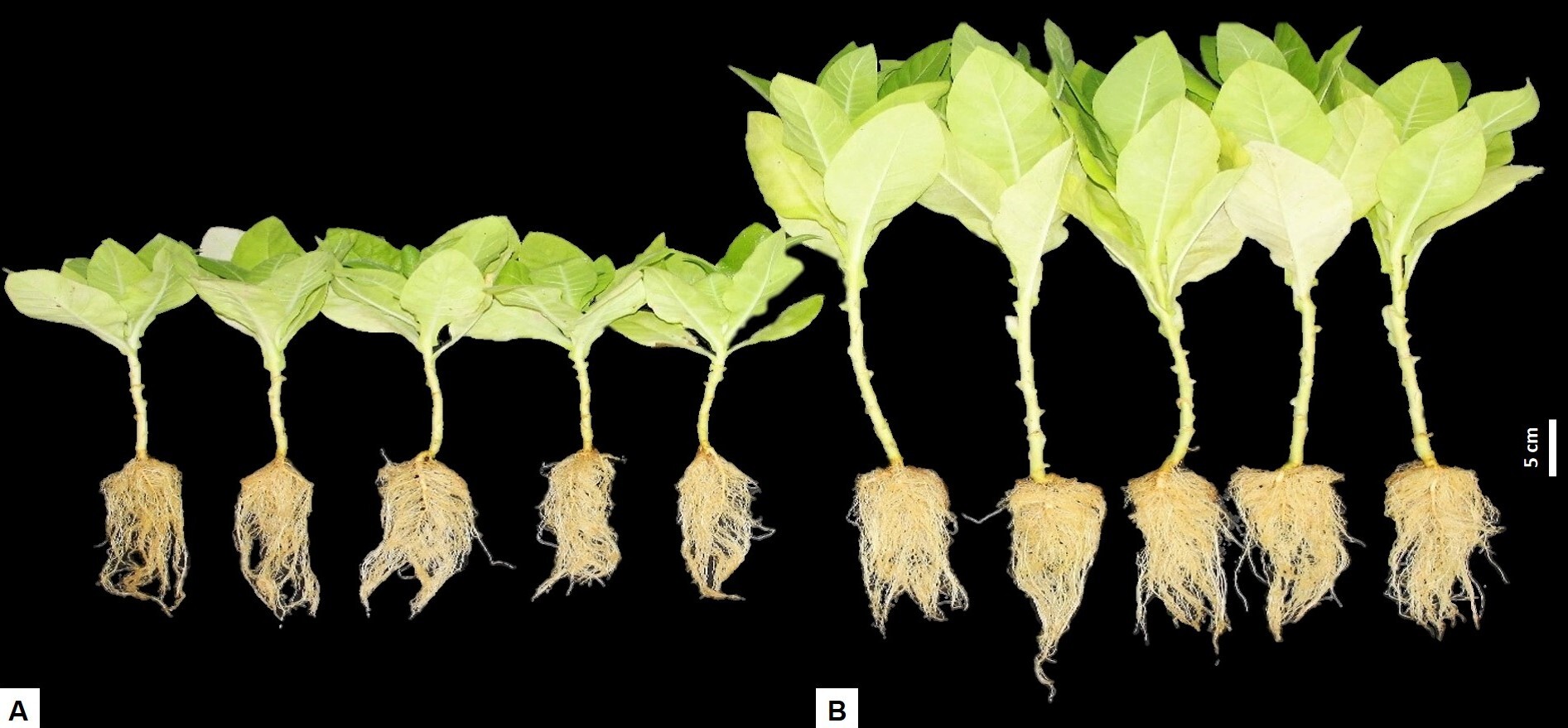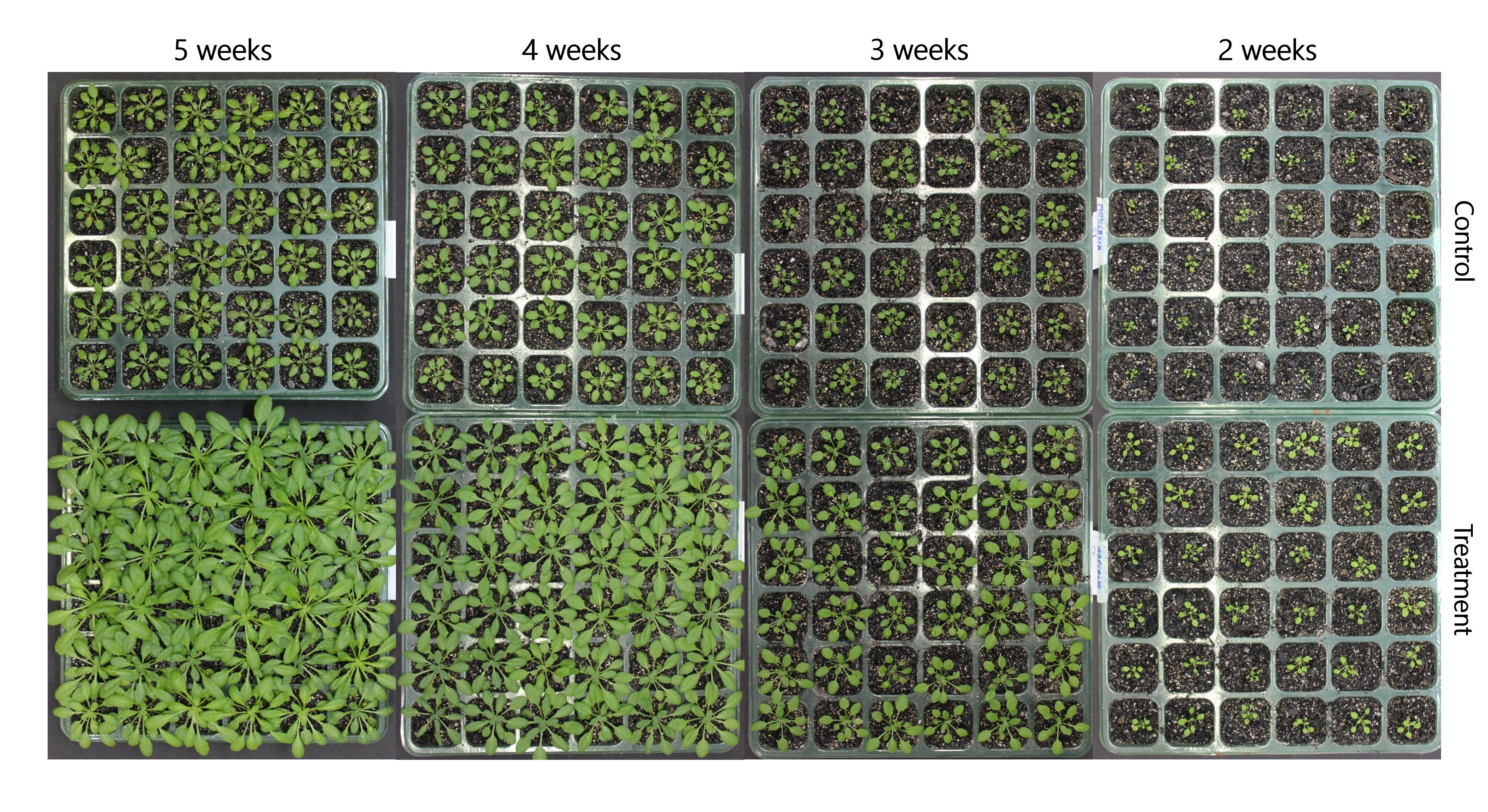


Tobacco plant grown with chalcone (right) and without the compound (left) (credits: Nicholas Vinícius Silva and Mariana Teixeira Rebouças)
Published on 07/15/2025
By Luciana Constantino | Agência FAPESP – Researchers at the Genomics and Bioenergy Laboratory (LGE) at the University of Campinas (UNICAMP) in the state of São Paulo, Brazil, have obtained a patent for a biostimulant fertilizer that induces seed germination and accelerates plant growth. This fertilizer has the potential to be used in agriculture and forest restoration.
The solution contains chalcone, a chemical compound from the flavonoid family that plays an important role in plant defense. Chalcone also has antioxidant, anti-inflammatory, antimicrobial, and antifungal properties. The group is now accepting proposals from interested parties for licensing and commercializing the formula.
The growth effect was discovered during an experiment exploring the impact of chalcone on plants under water stress. The experiment was conducted by Mariana Teixeira Rebouças, a chemical process technologist. At the time of the research, she held a scientific initiation scholarship from FAPESP at LGE.
“Researchers at the laboratory had already been studying the effects of chalcone on eucalyptus production. However, the plant’s cycle is long. We began testing other varieties, such as Arabidopsis thaliana, tobacco, sugarcane, and sorghum. During follow-up, we noticed that the treated plants looked bigger than those in the control group. We conducted other experiments and were able to demonstrate its effectiveness,” says Rebouças. She currently works at a chemical company developing agricultural formulations, fertilizers, and pesticides.
Together with biotechnologist Nicholas Vinícius Silva, who was pursuing his doctorate at the time, they tested the formulation on native seedlings from the Atlantic Forest, with positive results. “Even with the results obtained at UNICAMP, we wanted to go further. I have an aunt who owns a seedling nursery in the interior of São Paulo. I saw an opportunity to test what we produced and, at the same time, bring technology to where I came from with the purpose of recovering deforested areas and water sources. Seeing native seedlings, which used to take six months to go to the field, ready in just three months was indescribable. I’m proud to see the research becoming a reality,” she says.
The work was described in Silva’s 2022 doctoral thesis, “Unraveling the role of trans-chalcone flavonoids in plant growth and development,” which was completed at UNICAMP under the guidance of Professor Gonçalo Pereira, the coordinator of the LGE.
Impact
According to the results, the use of the formula in low doses (0.01 to 0.03 millimolar [mM]) promoted growth in the height of the aerial part of several plants, increased the diameter of the stem, and enhanced the length and density of the root system. Germination was also favored. However, at high doses (greater than or equal to 0.1 mM), inhibitory effects were observed in the seed.
Upon analyzing the transcriptomic profile of Arabidopsis thaliana leaves treated with a 0.01 mM dose of chalcone, evidence was found that this treatment alters the metabolism of phenylpropanoids (organic compounds derived from the amino acid phenylalanine), as well as photosynthesis and energy metabolism in the plants. This results in greater adaptability and development.
Considered a model plant in biology and one of the most studied species in the world, Arabidopsis is a weed native to temperate climates whose genome was fully sequenced in 2000. It is easy to grow and has a life cycle of up to six weeks.
The study found that the rosette area size of Arabidopsis thaliana increased by more than 75% with the application of chalcone, compared to control plants. Plants germinated in a supplemented medium showed 94% root growth. Tobacco plants exhibited a 130% increase in height, a 148% increase in biomass of the aerial part, and a 40% increase in stem diameter. Additionally, their root performance was similar to that of Arabidopsis.

(credits: Nicholas Vinícius Silva and Mariana Teixeira Rebouças)
“The gene expression of chalcone had already become evident when we were working on the Genolyptus project, a consortium of universities, research institutions, and eucalyptus companies dedicated to genetic improvement. We’d previously discovered a flavonoid production pathway that was activated in some varieties with higher-quality wood. We sought to understand what would happen if we added chalcone to eucalyptus trees with lower-quality wood. However, its cycle is much longer,” recalls researcher Jorge Lepikson Neto, Silva’s co-advisor.
Lepikson Neto, now an agroindustry manager at Senai Cimatec (the Integrated Manufacturing and Technology Campus of the National Industrial Learning Service – a non-profit initiative of CNI, the National Confederation of Industry), was a member of the LGE for years. There, he conducted postdoctoral research with support from FAPESP (projects 13/17846-0 and 12/22652-7). In 2018, he obtained a patent for a composition and method that allow eucalyptus wood to be modified without transgenics for optimal use by the paper industry and for energy generation.
The scientific article, “mRNA sequencing of Eucalyptus urograndis trees supplemented with flavonoids shows changes in metabolic process and decrease of lignification,” can be read in the journal BMC Proceedings.
The step-by-step of science
The LGE, which has obtained around 50 patents to date, began its activities in April 1997 as the Genomics and Expression Laboratory at the Institute of Biology at UNICAMP.
It started the bioinformatics group in the Xylella fastidiosa Genome program, which was also launched that year by FAPESP with support from the Citrus Defense Fund (FUNDECITRUS). At the time, it was considered the largest scientific project in Brazil, with an investment of USD 15 million. Xylella fastidiosa was the first phytopathogen in the world to have its genome sequenced – 2.7 million bases of the chromosome of this bacterium, which causes diseases in agricultural crops such as yellowing and is one of the worst pests of orange groves in São Paulo (read more at revistapesquisa.fapesp.br/en/boost-for-brazilian-science/).
“We obtained authorization to purchase high-cost equipment that allowed us to make DNA chips [a technique that analyzes thousands of genes at the same time]. And with Jorge’s research on eucalyptus, we developed the chalcone-linked line. When FAPESP authorized the purchase, I even opened a bottle of champagne. I hadn’t planned it, but I remembered that I still have the cork here. It has the date, 12/22/1999,” says Professor Pereira, smiling as he shows the cork to Agência FAPESP during a video interview.
“I say this to demonstrate the importance of basic science. You want to discover a phenomenon, but when you start, you don’t really know where you’re going to end up,” he adds.
In recent years, scientists at the laboratory have applied not only genomics, but also various bioinformatics approaches to bioenergy studies, with a focus on biomass crops such as sugarcane, macauba, and, more recently, agave (read more at agencia.fapesp.br/53058).
Source: https://agencia.fapesp.br/55324